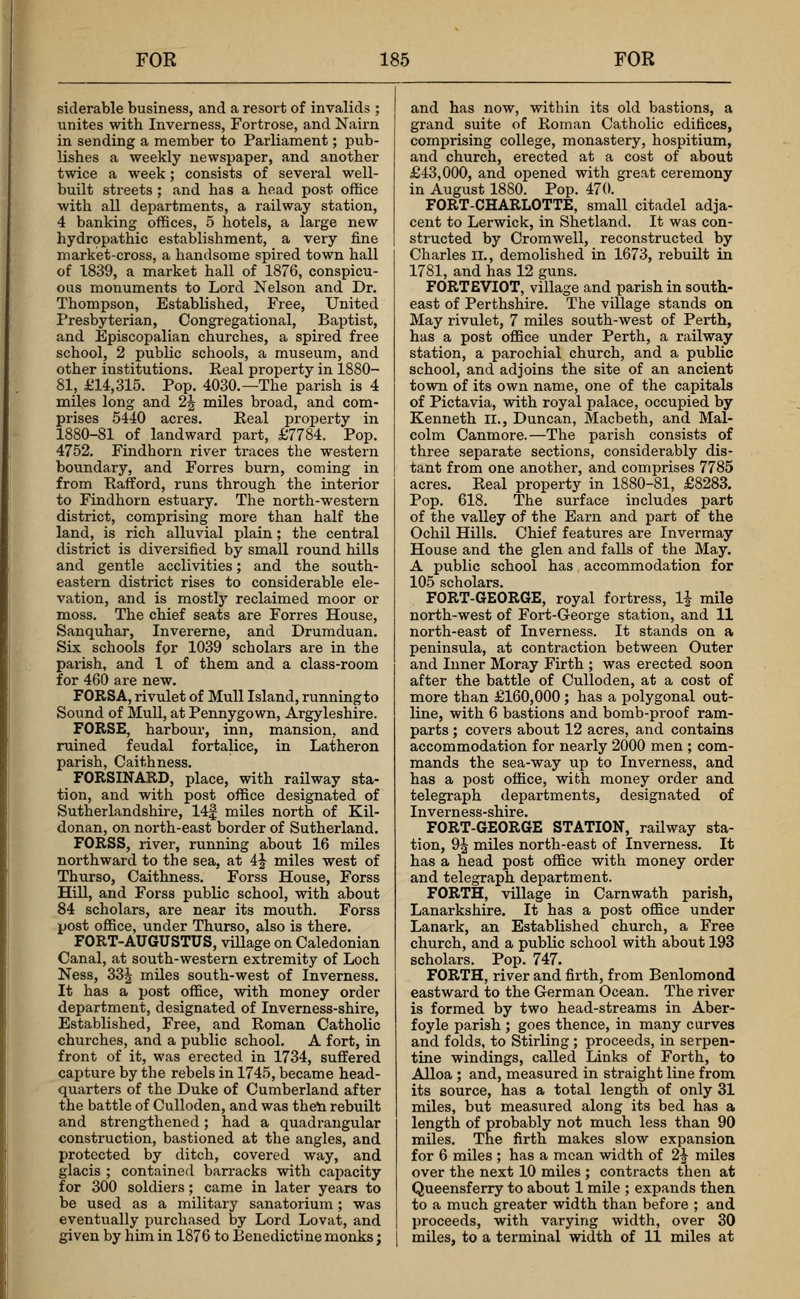FORSA, rivulet of Mull Island, runningto Sound of Mull, at Pennygown, Argyleshire.
FORSE, harbour, inn, mansion, and ruined feudal fortalice, in Latheron parish, Caithness.
FORSINARD, place, with railway station, and with post office designated of Sutherlandshire, 14f miles north of Kildonan, on north-east border of Sutherland.
FORSS, river, running about 16 miles northward to the sea, at 4J miles west of Thurso, Caithness. Forss House, Forss Hill, and Forss public school, with about 84 scholars, are near its mouth. Forss post office, under Thurso, also is there.
FORT-AUGUSTUS, village on Caledonian Canal, at south-western extremity of Loch Ness, 33J miles south-west of Inverness. It has a post office, with money order department, designated of Inverness-shire, Established, Free, and Roman Catholic churches, and a public school. A fort, in front of it, was erected in 1734, suffered capture by the rebels in 1745, became head-quarters of the Duke of Cumberland after the battle of Culloden, and was theft rebuilt and strengthened ; had a quadrangular construction, bastioned at the angles, and protected by ditch, covered way, and glacis ; contained barracks with capacity for 300 soldiers ; came in later years to be used as a military sanatorium ; was eventually purchased by Lord Lovat, and given by him in 1876 to Benedictine monks ; and has now, within its old bastions, a grand suite of Roman Catholic edifices, comprising college, monastery, hospitium, and church, erected at a cost of about 43,000, and opened with great ceremony in August 1880. Pop. 470.
FORT-CHARLOTTE, small citadel adjacent to Lerwick, in Shetland. It was constructed by Cromwell, reconstructed by Charles II., demolished in 1673, rebuilt in 1781, and has 12 guns.
FORTEVIOT, village and parish in south-east of Perthshire. The village stands on May rivulet, 7 miles south-west of Perth, has a post office under Perth, a railway station, a parochial church, and a public school, and adjoins the site of an ancient town of its own name, one of the capitals of Pictavia, with royal palace, occupied by Kenneth n., Duncan, Macbeth, and Malcolm Canmore. The parish consists of three separate sections, considerably distant from one another, and comprises 7785 acres. Real property in 1880-81, 8283. Pop. 618. The surface includes part of the valley of the Earn and part of the Ochil Hills. Chief features are Invermay House and the glen and falls of the May. A public school has accommodation for 105 scholars.
FORT-GEORGE, royal fortress, 1 mile north-west of Fort-George station, and 11 north-east of Inverness. It stands on a peninsula, at contraction between Outer and Inner Moray Firth ; was erected soon after the battle of Culloden, at a cost of more than 160,000 ; has a polygonal out-line, with 6 bastions and bomb-proof ram-parts ; covers about 12 acres, and contains accommodation for nearly 2000 men ; commands the sea-way up to Inverness, and has a post office, with money order and telegraph departments, designated of Invern ess-shire.
FORT-GEORGE STATION, railway station, 9 miles north-east of Inverness. It has a head post office with money order and telegraph department.
FORTH, village in Carnwath parish, Lanarkshire. It has a post office under Lanark, an Established church, a Free church, and a public school with about 193 scholars. Pop. 747.
FORTH, river and firth, from Benlomond eastward to the German Ocean. The river is formed by two head-streams in Aberfoyle parish ; goes thence, in many curves and folds, to Stirling ; proceeds, in serpentine windings, called Links of Forth, to Alloa ; and, measured in straight line from its source, has a total length of only 31 miles, but measured along its bed has a length of probably not much less than 90 miles. The firth makes slow expansion for 6 miles ; has a mean width of 2J miles over the next 10 miles ; contracts then at Queensferry to about 1 mile ; expands then to a much greater width than before ; and proceeds, with varying width, over 30 miles, to a terminal width of 11 miles at exit to the German Ocean between Fife and East Lothian. Much of the river's valley is carse land; and most of the firth's flanks are diversified and picturesque, j

